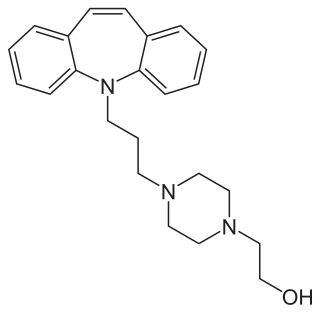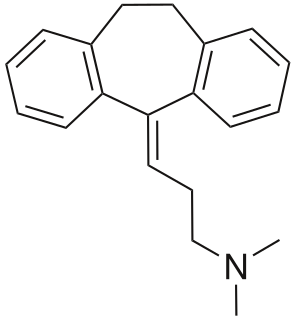
A heterocyclic compound or ring structure is a cyclic compound that has atoms of at least two different elements as members of its ring(s). Heterocyclic chemistry is the branch of organic chemistry dealing with the synthesis, properties, and applications of these heterocycles.

Tricyclic antidepressants (TCAs) are a class of medications that are used primarily as antidepressants, which is important for the management of depression. They are second-line drugs next to SSRI. TCAs were discovered in the early 1950s and were marketed later in the decade. They are named after their chemical structure, which contains three rings of atoms. Tetracyclic antidepressants (TeCAs), which contain four rings of atoms, are a closely related group of antidepressant compounds.

Tetracyclic antidepressants (TeCAs) are a class of antidepressants that were first introduced in the 1970s. They are named after their tetracyclic chemical structure, containing four rings of atoms, and are closely related to the tricyclic antidepressants (TCAs), which contain three rings of atoms.

Maprotiline, sold under the brand name Ludiomil among others, is a tetracyclic antidepressant (TeCA) that is used in the treatment of depression. It may alternatively be classified as a tricyclic antidepressant (TCA), specifically a secondary amine. In terms of its chemistry and pharmacology, maprotiline is closely related to other secondary amine TCAs like nortriptyline and protriptyline, and has similar effects to them.
There are many hundreds of thousands of possible drugs. Any chemical substance with biological activity may be considered a drug. This list categorises drugs alphabetically and also by other categorisations.

Imipramine, sold under the brand name Tofranil, among others, is a tricyclic antidepressant (TCA) mainly used in the treatment of depression. It is also effective in treating anxiety and panic disorder. The drug is also used to treat bedwetting. Imipramine is taken by mouth.

Nortriptyline, sold under the brand name Pamelor, among others, is a medication used to treat depression, neuropathic pain, attention deficit hyperactivity disorder (ADHD), smoking cessation and anxiety. As with many antidepressants, its use for young people with depression and other psychiatric disorders may be limited due to increased suicidality in the 18-24 population initiating treatment. Nortriptyline is a less preferred treatment for ADHD and stopping smoking. It is taken by mouth.

Butriptyline, sold under the brand name Evadyne among others, is a tricyclic antidepressant (TCA) that has been used in the United Kingdom and several other European countries for the treatment of depression but appears to no longer be marketed. Along with trimipramine, iprindole, and amoxapine, it has been described as an "atypical" or "second-generation" TCA due to its relatively late introduction and atypical pharmacology. It was very little-used compared to other TCAs, with the number of prescriptions dispensed only in the thousands.

Opipramol, sold under the brand name Insidon among others, is an anxiolytic and antidepressant that is used throughout Europe. Despite chemically being a tricyclic dibenzazepine (iminostilbene) derivative similar to imipramine, opipramol is not a monoamine reuptake inhibitor like most other tricyclic antidepressants, and instead, uniquely among antidepressants, acts primarily as a sigma receptor agonist. It was developed by Schindler and Blattner in 1961.

Tricyclics are chemical compounds that contain three interconnected rings of atoms.

Alfetamine, or alpha-allyl-phenethylamine, is a chemical compound of the phenethylamine family. It was briefly investigated as a possible antidepressant in the early 1970s. Its activity profile was said to be very similar to imipramine and amitriptyline, two tricyclic antidepressants. It has now been largely superseded by the newer compounds in this class, and only rarely found in scientific literature. The "alpha" in its name refers to its prodrug form, alfetamine. In addition to being an antidepressant, alfetamine is also a neuroprotective agent that acts as a weak dopamine antagonist and a high affinity κ-opioid receptor agonist.

Tricyclic antidepressant overdose is poisoning caused by excessive medication of the tricyclic antidepressant (TCA) type. Symptoms may include elevated body temperature, blurred vision, dilated pupils, sleepiness, confusion, seizures, rapid heart rate, and cardiac arrest. If symptoms have not occurred within six hours of exposure they are unlikely to occur.

Tandamine is a selective norepinephrine reuptake inhibitor with a tricyclic structure. It was developed in the 1970s as an antidepressant but was never commercialized. Tandamine is analogous to pirandamine, which, instead, acts as a selective serotonin reuptake inhibitor (SSRI).

Quinupramine is a tricyclic antidepressant (TCA) used in Europe for the treatment of depression.

Dimetacrine, also known as dimethacrine and acripramine, is a tricyclic antidepressant (TCA) used in Europe and formerly in Japan for the treatment of depression. It has imipramine-like effects; though, in a double-blind clinical trial against imipramine, dimetacrine was found to have lower efficacy in comparison and produced more weight loss and abnormal liver tests. Little is known about the pharmacology of dimetacrine, but it can be inferred that it acts in a similar manner to other TCAs. If this is indeed the case, dimetacrine may induce severe cardiac toxicity in overdose.
Flupentixol/melitracen is a combination of two psychoactive agents flupentixol and melitracen, a tricyclic antidepressant (TCA) which has antidepressant properties. It is designed for short term usage only. It is produced by Lundbeck.
The molecular formula C9H11N may refer to:

Tetracyclics are chemical compounds that contain four interconnected rings of atoms, e.g. Tröger's base.

Noxiptiline, also known as noxiptyline and dibenzoxine, is a tricyclic antidepressant (TCA) that was introduced in Europe in the 1970s for the treatment of depression. It has imipramine-like effects, acting as a serotonin and norepinephrine reuptake inhibitor, among other properties. Of the TCAs, noxiptiline has been described as one of the most effective, rivaling amitriptyline in clinical efficacy.

Tiazesim (INN), or thiazesim, previously sold under the brand name Altinil, is a heterocyclic antidepressant related to the tricyclic antidepressants (TCAs) which, first introduced in 1966 by Squibb Corporation, has since been discontinued and is no longer marketed.















